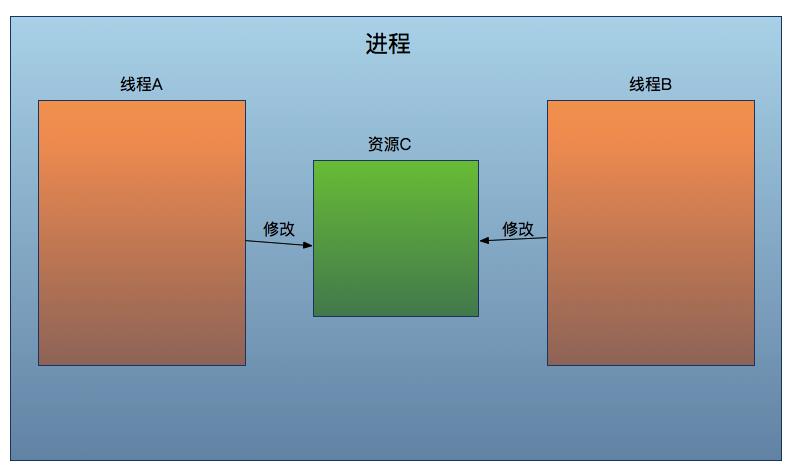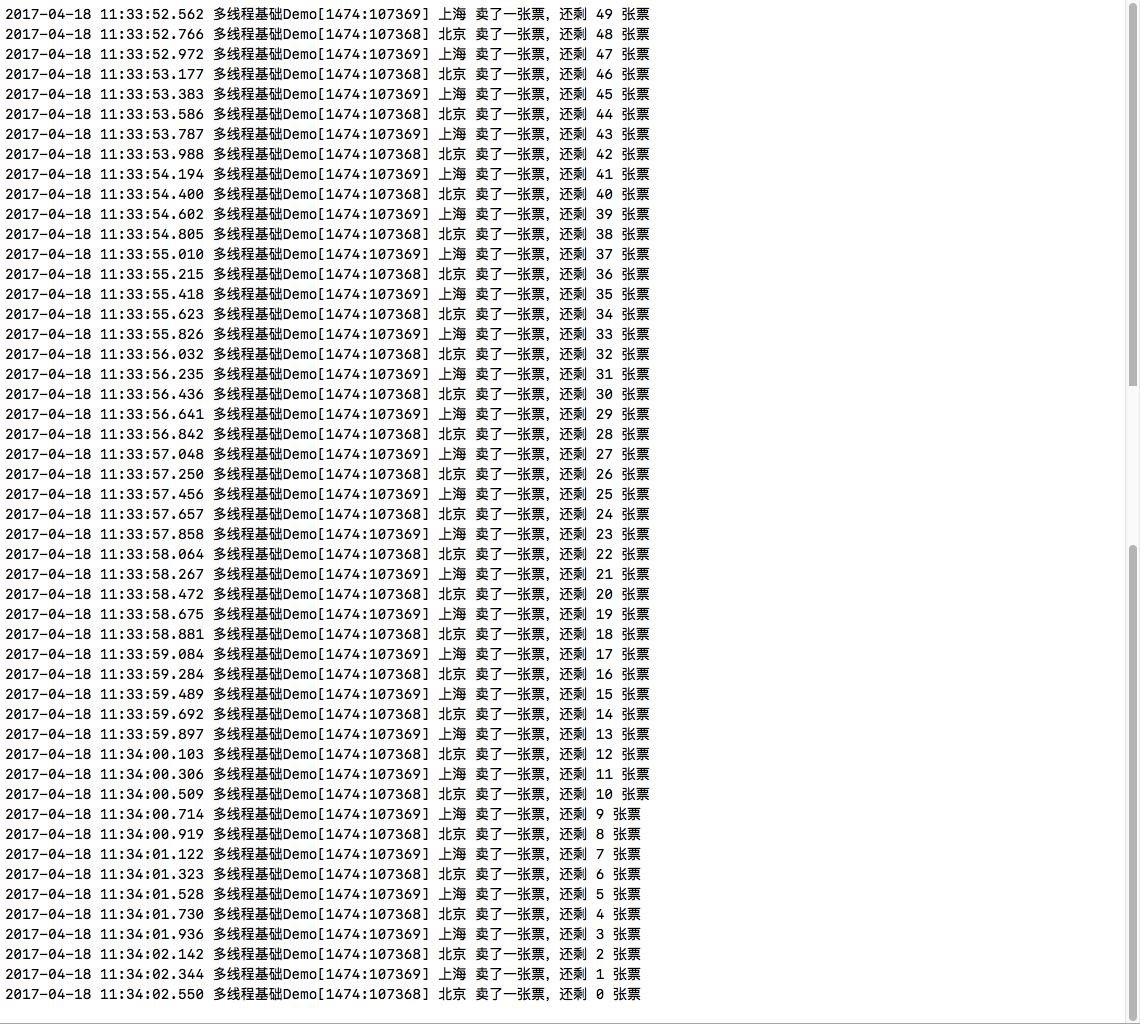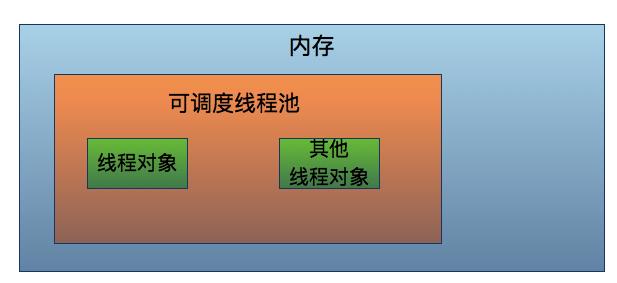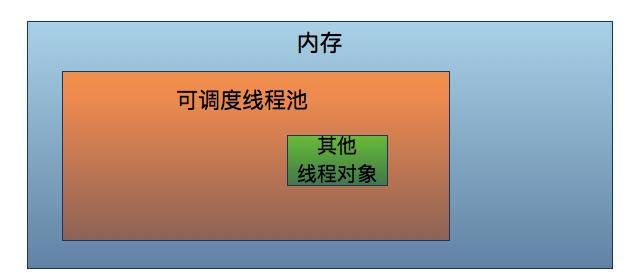iOS —— 多线程应用
Posted 透心凉mmm
tags:
篇首语:本文由小常识网(cha138.com)小编为大家整理,主要介绍了iOS —— 多线程应用相关的知识,希望对你有一定的参考价值。
一、共享资源
共享资源 : 就是内存中的一块资源同时被多个进程所访问,而每个进程可能会对该资源的数据进行修改
问题 : 如果 线程A 访问了某块资源 C,并且修改了其中的数据,此时 线程B 也访问了 资源C,并且也对 C 中的数据进行了修改;那么等到 线程A 和 线程B 执行结束后,此时,资源C 中的数据就并不是最初的设置了
如图

此时,如果用户想获取 被 线程A 修改的 资源C 的数据,但是 资源C 的数据也被 线程B 修改了,所以获得的是错误的数据;如果用户想获取 被 线程B 修改的 资源C 的数据,但是 资源C 的数据也被 线程A 修改了,所以获得的是错误的数据
下面看代码,以出售火车票为例
建立火车票数据模型
1 // LHTicketModal.h 2 #import <Foundation/Foundation.h> 3 4 @interface LHTicketModal : NSObject 5 6 @property (nonatomic) NSUInteger ticketCount; // 剩余票数 7 @property (nonatomic) NSUInteger ticketSaleCount; // 卖出数量 8 9 @end 10 11 // LHTicketModal.m 12 #import "LHTicketModal.h" 13 14 static const NSUInteger kTicketTotalCount = 50; 15 16 @implementation LHTicketModal 17 18 - (instancetype)init { 19 20 self = [super init]; 21 22 if (self) { 23 24 // 初始化剩余票数应该为总数 25 _ticketCount = kTicketTotalCount; 26 27 // 初始化卖出票数应该为 0 28 _ticketSaleCount = 0; 29 30 } 31 32 return self; 33 34 } 35 36 @end
UIViewController 代码,声明两个线程,分别代表两个地点
1 // LHSharedViewController.h 2 #import "LHSharedViewController.h" 3 #import "LHTicketModal.h" 4 5 @interface LHSharedViewController () 6 7 // 车票模型 8 @property (nonatomic, strong) LHTicketModal * ticket; 9 10 // 线程对象 11 @property (nonatomic, strong) NSThread * threadBJ; 12 @property (nonatomic, strong) NSThread * threadSH; 13 14 @end 15 16 // LHSharedViewController.m 17 @implementation LHSharedViewController 18 19 - (void)viewDidLoad { 20 21 [super viewDidLoad]; 22 23 // 1. 初始化 票数模型对象 24 _ticket = [[LHTicketModal alloc] init]; 25 26 // 2. 初始化 线程对象 并设置线程名 27 _threadBJ = [[NSThread alloc] initWithTarget:self selector:@selector(sellTickets:) object:@"北京卖出"]; 28 29 _threadBJ.name = @"北京"; 30 31 _threadSH = [[NSThread alloc] initWithTarget:self selector:@selector(sellTickets:) object:@"上海卖出"]; 32 33 _threadSH.name = @"上海"; 34 35 } 36 37 // 线程执行的方法 38 - (void)sellTickets:(NSString *)str { 39 40 while (YES) { 41 42 // 判断剩余量是否大于 0,大于 0 才可以卖出 43 if (_ticket.ticketCount > 0) { 44 45 // 暂停一段时间 46 [NSThread sleepForTimeInterval:0.2]; 47 48 // 卖出一张票,剩余票数减 1,卖出票数加 1 49 _ticket.ticketCount--; 50 51 _ticket.ticketSaleCount++; 52 53 // 获取当前进程 54 NSThread * currentThread = [NSThread currentThread]; 55 56 NSLog(@"%@ 卖了一张票,还剩 %lu 张票", currentThread.name, _ticket.ticketCount); 57 58 } 59 60 } 61 62 } 63 64 // 按钮的动作方法 65 - (IBAction)startSaleBtnClick:(id)sender { 66 67 // 开启线程 68 [_threadBJ start]; 69 70 [_threadSH start]; 71 72 73 }
点击按钮后,线程开始运行,结果如图

看一看出,共享资源同时被多个线程访问并修改,导致用户取得了错误的数据
那么解决这种情况的办法就是 加锁
加锁是指对一段代码进行加锁,加锁之后,若一个线程已经在对共享资源的数据修改,此时就不会再有其他线程来访问该资源进行修改,直至当前线程已经结束修改资源的代码时,其他进程才可以对其进行修改
可以把共享资源看做一个房间,线程看做人;当一个人进入房间之后就会锁门(加锁),对房间进行各种布置,此时其他人是进不来的,因为没有钥匙;直至当前的人出房间,其他的人才可以进房间进行布置
加锁的方式有多种,这里介绍两种
方式一 : 使用 @synchronized (加锁对象) {} 关键字
只需修改上述代码的 sellTickets 方法,其余不变,这里将其方法名改为 sellTickets_v2
1 - (void)sellTickets_v2:(NSString *)str { 2 3 while (YES) { 4 5 // 对当前对象加锁 6 @synchronized (self) { 7 8 // 判断剩余量是否大于 0,大于 0 才可以卖出 9 if (_ticket.ticketCount > 0) { 10 11 // 暂停一段时间 12 [NSThread sleepForTimeInterval:0.2]; 13 14 // 卖出一张票,剩余票数减 1,卖出票数加 1 15 _ticket.ticketCount--; 16 17 _ticket.ticketSaleCount++; 18 19 // 获取当前进程 20 NSThread * currentThread = [NSThread currentThread]; 21 22 NSLog(@"%@ 卖了一张票,还剩 %lu 张票", currentThread.name, _ticket.ticketCount); 23 24 } 25 26 } 27 28 } 29 30 }
再次运行程序,点击按钮。结果如图

方式二 : 使用 NSCondition 类
在 类扩展中声明并在 viewDidLoad 方法中初始化
1 - (void)sellTickets_v3:(NSString *)str { 2 3 while (YES) { 4 5 // 使用 NSCondition 加锁 6 [_ticketCondition lock]; 7 8 // 判断剩余量是否大于 0,大于 0 才可以卖出 9 if (_ticket.ticketCount > 0) { 10 11 // 暂停一段时间 12 [NSThread sleepForTimeInterval:0.2]; 13 14 // 卖出一张票,剩余票数减 1,卖出票数加 1 15 _ticket.ticketCount--; 16 17 _ticket.ticketSaleCount++; 18 19 // 获取当前进程 20 NSThread * currentThread = [NSThread currentThread]; 21 22 NSLog(@"%@ 卖了一张票,还剩 %lu 张票", currentThread.name, _ticket.ticketCount); 23 24 } 25 26 // 使用 NSCondition 解锁 27 [_ticketCondition unlock]; 28 29 } 30 31 }
运行结果和上述一样
使用 NSCondition 时,将加锁的代码放在 loac 和 unlock 中间
总结 :
1. 互斥锁的优缺点
优点 : 有效防止因多线程抢夺资源造成的数据安全问题
缺点 : 需要消耗大量 CPU 资源
2. 互斥锁使用的前提
多个线程抢夺同一资源
线程同步,互斥锁就是使用了线程同步
二、线程通信
通常, 一个线程不应该单独存在,应该和其他线程之间有关系
例如 : 一个线程完成了自己的任务后需要切换到另一个线程完成某个任务;或者 一个线程将数据传递给另一个线程
看代码,现在 xib 中拖入一个 按钮,并设置其动作方法,如下
1 - (IBAction)btn1Click:(id)sender { 2 3 // 1. 获取主线程 4 NSLog(@"mainThread --- %@", [NSThread mainThread]); 5 6 // 2. 创建子线程并完成指定的任务 7 [self performSelectorInBackground:@selector(run1:) withObject:@"子线程中执行方法"]; 8 9 } 10 11 - (void)run1:(NSString *)str { 12 13 // 1. 获取当前线程 14 NSThread * currentThread = [NSThread currentThread]; 15 16 NSLog(@"currentThread --- %@ --- %@", currentThread, str); 17 18 // 2. 回到主线程中执行指定的方法 19 [self performSelectorOnMainThread:@selector(backMainThread:) withObject:@"回到主线程" waitUntilDone:YES]; 20 21 } 22 23 - (void)backMainThread:(NSString *)str { 24 25 // 1. 获取当前线程(主线程) 26 NSThread * currentThread = [NSThread currentThread]; 27 28 NSLog(@"currentThread --- %@ --- %@", currentThread, str); 29 30 }
这里通过 performSelectorInBackground: withObject: 方法创建一个子线程并完成指定的任务(run1:),然后在子线程中又通过
performSelectorOnMainThread: withObject: waitUntilDone: 方法回到主线程中完成指定的任务(backMainThread:)
点击按钮,运行结果如下

三、线程的状态
1. 当一个线程对象创建并开启后,它就会被放到线程调度池中,等待系统调度;如图

2. 当正在运行的线程被阻塞时,就会被移出 可调度线程池,此时不可再调度它

3. 当线程正常结束,异常退出,强制退出时都会导致该线程死亡,死亡的线程会从内存中移除,无法调度

代码如下
在 xib 中拖入一个 按钮,并设置其动作方法
1 #import "LHThreadStateViewController.h" 2 3 @interface LHThreadStateViewController () 4 5 @property (nonatomic, strong) NSThread * thread; 6 7 @end 8 9 @implementation LHThreadStateViewController 10 11 - (void)viewDidLoad { 12 13 [super viewDidLoad]; 14 15 // 1. 初始化线程对象 16 _thread = [[NSThread alloc] initWithTarget:self selector:@selector(runThread:) object:@"子线程执行任务"]; 17 18 _thread.name = @"线程A"; 19 20 } 21 22 - (IBAction)startThreadClick:(id)sender { 23 24 // 1. 获取主线程 25 NSLog(@"mainThread --- %@", [NSThread mainThread]); 26 27 // 线程开始 28 [_thread start]; 29 30 } 31 32 - (void)runThread:(NSString *)str { 33 34 // 1. 获取当前线程 35 NSThread * currentThread = [NSThread currentThread]; 36 37 NSLog(@"currentThread --- %@", currentThread); 38 39 // 2. 阻塞 2s 40 NSLog(@"线程开始阻塞 2s"); 41 42 [NSThread sleepForTimeInterval:2.0]; 43 44 NSLog(@"线程结束阻塞 2s"); 45 46 // 3. 阻塞 4s 47 NSLog(@"线程开始阻塞 4s"); 48 49 // 创建 NSDate 对象,并从当前开始推后 4s 50 NSDate * date = [NSDate dateWithTimeIntervalSinceNow:4.0]; 51 52 [NSThread sleepUntilDate:date]; 53 54 NSLog(@"线程结束阻塞 4s"); 55 56 // 4. 退出线程 57 for (int i = 0; i < 10; ++i) { 58 59 if (i == 7) { 60 61 // 结束当前线程,之后的语句不会再执行 62 [NSThread exit]; 63 64 NSLog(@"线程结束"); 65 66 } 67 68 NSLog(@"%i --- %@", i, currentThread); 69 70 } 71 72 }
42 行使用 sleepForTimeInterval: 方法使得当前线程阻塞指定的时间
52 行使用 sleepUntilDate: 方法使得当前线程阻塞 参数中设定的时间;该参数必须是 NSDate 对象,并且以当前时间作为基准
62 行使用 exit 方法退出当前线程,并且退出后,该方法之后的语句不再会执行,上述中即 64 行代码不会执行
点击按钮,运行结果如下

注意 : 当 执行 exit 方法后,表示当前的线程已经死亡,即从内存中移除了,若此时再点击按钮(该线程在内存中已经没有空间了),程序会崩溃,并报以下的错误

以上是关于iOS —— 多线程应用的主要内容,如果未能解决你的问题,请参考以下文章